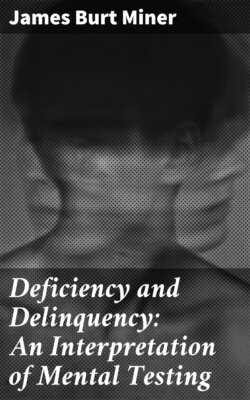Читать книгу Deficiency and Delinquency: An Interpretation of Mental Testing - James Burt Miner - Страница 12
B. The Assumptions of a Quantitative Definition. (a) Deficiency is a difference in degree not in kind.
ОглавлениеFortunately the tendency to describe the feeble-minded person as if he were a different species from the normal has been definitely attacked by two noteworthy researches, that of Norsworthy (159) and that of Pearson and Jaederholm (164) (167). In these two investigations mentally deficient children either in special classes or in institutions have been compared with groups of normal children from the same localities on the basis of objective tests. The results are uniformly supported by numerous other studies of deficient and normal groups with the Binet and other tests. The conclusion is, therefore, thoroughly established that there is no break in the continuity of mental ability. It grades off gradually from average ability, and continually fewer and fewer individuals are to be found at each lower degree of ability. The borderline of deficiency will, therefore, not be a mental condition which clearly separates different kinds of ability, but a limiting degree of capacity to be decided upon by social policy in attempting to care for those who most need social guardianship. Since ability changes gradually in degree it is necessary to indicate a doubtful border region of degrees of ability on which expert judgment must supplement the test diagnosis. Below the doubtful region the diagnosis is clearly supported by objective test criteria, so that the only question to raise is whether the condition is caused by removable handicaps. The percentage definition thus strictly conforms to the best objective studies of mental deficiency in treating deficiency as a difference in degree.
It should, perhaps, be said that this view is in direct conflict with the opinion that mental deficiency is accounted for as a Mendelian simple unit character. The opposing view has been advocated by Davenport (95, p. 310) and others in the publications of the Eugenics Record Office, and accepted by Goddard (112, p. 556). It has been so fully answered by Pearson (164) and Heron of the Galton Laboratory (127) and by Thorndike (198) that there is no occasion to take up the question in detail. We seem to be reaching an understanding so far as our present problem is concerned. If the explanation of the inheritance of mental ability is through Mendelian characters, nevertheless intellectual ability is the result of such a complex combination of units that it may best be thought of in connection with the unimodal distribution of ability adopted in this study. No random measurement of mental ability has ever shown any other form of distribution.
The attempt has also been made by Schmidt (179) to find qualitative differences between normal and feeble-minded children by means of tests, and by Louise and George Ordahl (162) to find qualitative differences between levels of intelligence among feeble-minded children. While these studies are very suggestive in pointing out the tests which most clearly indicate differences between individuals, they seem to me to fall far short of showing that the qualitative distinctions are anything more than larger quantitative distinctions. It is not clear that the authors intended them to mean anything more than this, so these studies do not seem to conflict seriously with our assumption that intellectual ability grades off gradually and uninterruptedly from medium ability to that of the lowest idiot.
